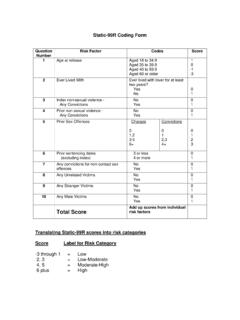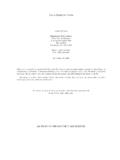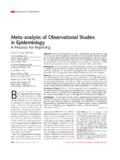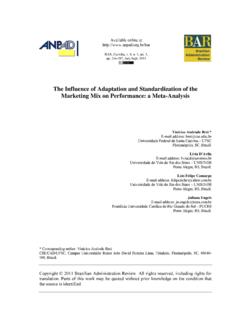Transcription of The Accuracy of Recidivism Risk Assessments for Sexual ...
1 The Accuracy of Recidivism Risk Assessments for Sexual Offenders:A Meta- analysis of 118 Prediction StudiesR. Karl HansonPublic Safety CanadaKelly E. Morton-BourgonDepartment of Justice, CanadaThis review compared the Accuracy of various approaches to the prediction of Recidivism among sexualoffenders. On the basis of a meta- analysis of 536 findings drawn from 118 distinct samples (45,398sexual offenders, 16 countries), empirically derived actuarial measures were more accurate than unstruc-tured professional judgment for all outcomes ( Sexual , violent, or any Recidivism ). The Accuracy ofstructured professional judgment was intermediate between the Accuracy found for the actuarial measuresand for unstructured professional judgment.
2 The effect sizes for the actuarial measures were moderate tolarge by conventional standards (averagedvalues of ); however, the utility of the actuarialmeasures will vary according to the referral question and samples assessed. Further research shouldidentify the psychologically meaningfully factors that contribute to risk for :risk assessment , Sexual offenders, meta-analysisAll societies must respond to individuals who commit seriousoffenses. One important determinant of these responses ( ,punishment, detention, supervision) is the perceived risk of recid-ivism. Sexual offenders, in particular, are often the subject ofspecial policies that are meant to improve community safety bymanaging Sexual offenders risk of future offending ( , postsen-tence detention, long-term community supervision).
3 The effective-ness of these policies rests on the ability of evaluators to accuratelydifferentiate offenders according to risk individual characteristics associated with Recidivism amongsexual offenders have been previously reviewed (Hanson & Bus-sie`re, 1998; Hanson & Morton-Bourgon, 2005). In general, the twobroad domains most strongly associated with Sexual Recidivism aresexual deviancy and lifestyle instability/criminality. The criminallifestyle characteristics ( , history of rule violation, substanceabuse) are also those most strongly related to violent and general(any) Recidivism among Sexual offenders (Hanson & Morton-Bourgon, 2004), general offenders (Gendreau, Little, & Goggin,1996), and mentally disordered offenders (Bonta, Law, & Hanson,1998).
4 Although a number of Recidivism risk factors have been identi-fied, the relationships between any single risk factor and recidi-vism are small. Consequently, a range of risk factors should beconsidered in competent evaluations. The question addressed inthe current review is the relative Accuracy of different methods ofcombining risk factors into a overall evaluation of is widely accepted that evaluations based on unstructuredprofessional judgment are less accurate than structured risk assess-ments (Andrews, Bonta, & Wormith, 2006; Janus & Prentky,2003; Monahan, 2007; Quinsey, Harris, Rice, & Cormier, 2006).
5 The general pattern has been documented for at least 50 years(Meehl, 1954), but only recently have forensic psychologists in theUnited States routinely used structured risk tools for evaluations ofadult Sexual offenders (Archer, Buffington-Vollum, Stredny, &Handel, 2006). In high-stakes evaluations, such as civil commit-ment procedures, most evaluators now consider structured risktools to be essential (Jackson & Hess, 2007).Static 99 (Hanson & Thornton, 2000) is by far the most com-monly used risk tool with adult Sexual offenders (Archer et al.,2006; Interstate Commission for Adult Offender Supervision,2007; Jackson & Hess, 2007; McGrath, Cumming, & Burchard,2003).
6 It contains 10 items covering static, historical factors, suchas the number of prior offenses, victim characteristics (unrelated,strangers, males), and the offender s age. None of the items wereintended to measure psychologically meaningful constructs; theywere selected purely on the basis of empirical relationships withrecidivism and ease of administration. The scores on each of theitems are summed to create a total score, and the total score isassociated with the observed Recidivism rates pooled from threedevelopment samples (n 1,086).Among forensic psychologists (Archer et al., 2006), the secondmost widely used measure is the Sexual Violence Risk 20 (SVR 20; Boer, Hart, Kropp, & Webster, 1997).
7 The SVR 20 covers 20R. Karl Hanson, Corrections Research, Public Safety Canada, Ottawa,Ontario, Canada; Kelly E. Morton-Bourgon, Department of Justice, views expressed are those of the authors and are not necessarilythose of Public Safety Canada, the Department of Justice, Canada, or ourmany colleagues who made this work possible. We thank the followingresearchers who provided unpublished studies, raw data, or findings notincluded in other reports: Tony Beech, Susanne Bengtson, Jim Bonta, LiamCraig, Jerome Endrass, Doug Epperson, Grant Harris, Mark Hanlon, Ray-mond Knight, Calvin Langton, Roxanne Lieb, Jan Looman, Larry Motiuk,Thierry Pham, Jean Proulx, John Reddon, Marnie Rice, Sue Righthand,Steve Saum, Greg Schiller, David Thornton, Daniel Wilcox, Robin Wilson,and Annie Yessine.
8 Thanks are also due to Caleb Lloyd and Leslie Helmusfor locating articles and formatting tables and to Leticia Gutierrez andKuan Li for translation of the Spanish and Chinese articles, concerning this article should be addressed to R. KarlHanson, Corrections Research, Public Safety Canada, 340 Laurier AvenueWest, Ottawa, Ontario K1A 0P8, Canada. E-mail: assessment 2009 Public Safety Canada2009, Vol. 21, No. 1, 1 211040-3590/09/$ DOI: of the offender s criminal history and psychological func-tioning. The items are meant to assess risk of Recidivism and toassist with case management.
9 Example items include past super-vision failure, Sexual deviation, psychopathy, major mental illness,employment problems, and lack of realistic plans. No explicitprocedure is provided for translating the ratings on the items intoan overall evaluation of risk. Boer et al. (1997) stated that risk willtypically increase monotonically with each additional risk factor,but they recommended against simply adding the items; instead,they directed evaluators to use their own professional judgment torate the risk as low, moderate, or high. Scores on the are SVR 20not linked to expected Recidivism Should Risk Tools Be Classified?
10 The differences between the above tools illustrate ongoing de-bates about how risk Assessments should be structured (Mona-han, 2007). The debate is not only about the relative predictiveaccuracy of specific tools; it also concerns the purpose of the riskassessment and the role of professional judgment. To appreciatethe different positions, one can consider the different ways inwhich structured risk Assessments have been conducted and of the discussion of methods for combining informationfor applied decision making in psychology has been shaped byMeehl s (1954) review of clinical versus statistical defined statistical (or actuarial) predictions as having twofeatures: They use an explicit method of combining the informa-tion, and that information is linked to a probability figure on thebasis of empirically determined relative frequencies (see alsoDawes, Faust, & Meehl, 1989.)








